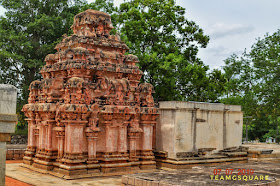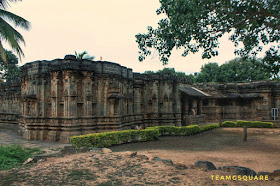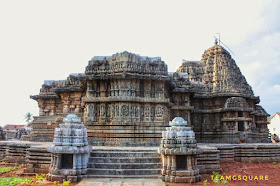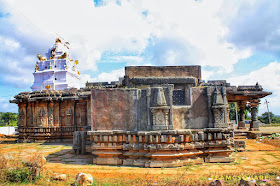101. Sri Mahakuteshwara Temple, Mahakuta
Taluk : Badami, Bagalkot
Dynasty : Badami Chalukyas in the 7th Century
About : This temple consists of a garbhagriha with pradakshinapatha, sabhamandapa, mukhamandapa and nandi mandapa. This temple is built of red sand stone, with Dravidian shikhara on the garbhagriha.
 |
| Sri Mahakuteshwara Temple, Mahakuta |
102. Sri Someshwara Temple, Gangavara
Taluk : Hosakote, Bengaluru (R)
Dynasty : Gangas in the 8th Century , Cholas in the10th Century
About : This temple consists of a garbhagriha, an antarala, mandapa, vestibule and a front porch, enclosed by prakara with an entrance mandapa in the North.
 |
| Sri Someshwara Temple, Gangavara |
103. Sri Someshwara Temple, Ulsooru
Taluk : Bengaluru (U)
Dynasty : Cholas in the 9th Century, Vijayanagara in the 15th Century & Nadaprabhus in the16th Century
About : One of the oldest temples in the heart of Bengaluru, this temple consists of a garbhagriha, two ardhamandapas, a navaranga, kalyana mandapa and rajagopuram. There is another temple dedicated to Goddess Kamakshamba.
 |
| Sri Someshwara Temple, Ulsooru |
Taluk : Kittur, Belagavi
Dynasty : Goa Kadambas in the12th Century
About : This dwikuta
(modified trikuta) temple is dedicated to Sri Kamala Narayana Swamy and
Goddess Lakshmi. This is
a unique dwikuta temple with a big devakoshtha (niche) in between the
two garbhagrihas, housing a beautiful murti of Sri Lakshmi
Narayana and decorated similar to the garbhagrihas. It is devoid of an
antarala and opens directly into
the navaranga. The other two garbhagrihas have elaborate antarala,
opening into
a common navaranga with two mukhamandapas facing them.
Read more.
 |
| Sri Kamala Narayana Temple, Degaon/Deganve |
Taluk : Khanapur, Belagavi
Dynasty : Banavasi Kadambas in the 5th Century, Goa Kadambas in the 12th Century & Kalyani Chalukyas in the 12th Century
About : This temple bears architectural resemblance to the Sri Madhukeshwara temple
at Banavasi to some extent. The temple has two garbhagrihas with an
attached antarala, opening into a common navaranga with 2 mukhamandapas.
The central ceiling of the navaranga carries a beautiful inverted lotus
motif, but is now covered by a wooden plank. The temple is built on
an elevated platform.
Read more.
 |
| Sri Bhuvaraha Narasimha Temple, Halasi |
Taluk : Ballari
Dynasty : Sindhs of Kurugodu in the 13th Century & Vijayanagara in the 16th Century
About : This temple consists of a garbhagriha, an antarala, a pradakshinapatha, an
open 60 pillared mahamandapa and a mukhamandapa. The temple is
dedicated to Lord Shiva in the form of a Linga.
Read More.
 |
| Sri Sangameshwara Temple, Kurugodu |
107. Sri Saraswathi Temple, Basava Kalyana
Taluk : Basava Kalyana, Bidar
Dynasty : Kalyani Chalukyas in the11th Century
About : This beautiful temple today consists only a garbhagriha, and is seen atop the hill-fort built by the Kalyani Chalukyas.
 |
| Sri Saraswathi Temple, Basava Kalyana |
108. Sri Lakshmi Narasimha Temple, Agara
Taluk : Kollegal, Chamarajanagar
Dynasty : Cholas in the 10th Century & Hoysalas in the 12th Century
About : A unique temple with circular garbhagriha, an antarala, navaranga, and 2 mukhamandapas with one of the rajagopurams surviving today. Sadly, no shikhara exists today. The murti of Lord Narasimha here is said to represent his five manifestations namely, Lord Yoga Narasimha (Lord seated in a yogic posture), Lord Lakshmi Narasimha (Lakshmi carved on the Lord's chest), Lord Ugra Narasimha (presence of the third eye), Lord Jwala Narasimha (presence of flames near the eyes of the Lord) & Lord Prahlada Narasimha (Prahlada sculpted near the Lord's leg).
 |
| Sri Lakshmi Narasimha Temple, Agara |
109. Sri Rameshwara Temple, Narsamangala
Taluk : Chamarajanagar
Dynasty : Gangas in the 9th Century, Cholas in the 10th Century & Hoysalas in the 12th Century
About : The main temple consists of a garbhagriha, an antarala, ardhamandapa, mukhamandapa with a detached nandi mandapa. The shikhara of the temple is in Dravidian style built of brick and mortar. Many smaller temples in the temple complex were later additions during the reign of the Cholas and the Hoysalas.
 |
| Sri Rameshwara Temple, Narsamangala |
Taluk : Yelandur, Chamarajanagar
Dynasty : Vijayanagara in the 16th Century
About : The main temple consists of a garbhagriha and an ardhamandapa, with the main feature of the temple complex being the 'BaLe mandapa' (bangle mandapa), now seen as a beautifully carved rajagopuram devoid of its shikara. More about this.
 |
| Sri Gaurishwara Temple, Yelandur |
111. Sri Harihareshwara Temple, Hariharapura
Taluk : Chikkaballapura
Dynasty : Nadaprabhus in the 16th Century
About : This temple consists of a garbhagriha, an antarala, navaranga and a mukhamandapa. An interesting feature of this temple is the carving on the inner walls.
 |
| Sri Harihareshwara Temple, Hariharapura |
112. Sri Markandeshwara Temple, Khandya
Taluk : Chikmagaluru
Dynasty : Hoysalas in the 12th Century & Keladi Nayakas in the 16th Century
About : This temple consists of a garbhagriha, sukhanasi with a pradakshinapatha, a navaranga and a mukhamandapa.
 |
| Sri Markandeshwara Temple, Khandya |
113. Sri Yoga Narasimha Temple, Baggavalli
Taluk : Chikmagaluru
Dynasty : Hoysalas in the13th Century
About : This temple consists of 3 garbhagrihas with antarala, and a common navaranga with mukhamandapa.
 |
| Sri Yoga Narasimha Temple, Baggavalli |
114. Sri Kodanda Rama Temple, Hiremagaluru
Taluk : Chikmagaluru
Dynasty : Gangas in 9th Century, Hoysalas in 13th Century & Wodeyars in 17th Century
About : This temple consists of a garbhagriha, with an antarala, a sukhanasi opening into a navaranga and a mukhamandapa.
 |
| Sri Kodanda Rama Temple, Hiremagaluru |
115. Twin Temples, Marale
Taluk : Chikmagaluru
Dynasty : Hoysalas in the12th Century
About : The beautiful twin temples of Marale are dedicated to Lords Chennakeshava and Siddeshwara. They are built with similar plans and consists of a garbhagriha with an antarala, a navaranga and a mukhamandapa.
 |
| Twin Temples, Marale |
116. Akka Thangi Twin Temples, Brahmagiri
Taluk : Molakalmuru, Chitradurga
Dynasty : Nolambas in the 9th Century , Hoysalas in the 12th century
About : Popularly called as Akka Thangi temple, these are twin temples out of which one remains completely destroyed with only its basement visible, while the other consists of a garbhagriha, an antarala and an open navaranga.
 |
| Akka Thangi Twin Temples, Brahmagiri |
Taluk : Molakalmuru, Chitradurga
Dynasty : Rastrakutas in the 9th century & Kalyani Chalukyas in the 11th Century
About : The temple complex consists of many small temples dedicated to Goddess Mahishasuramardhini and Lords Virabhadra, Ganesha, Parushurama, and Jatinga Rameshwara. Read More.
 |
| Sri Rameshwara Temple, Jatinga Rameshwara |
Taluk : Sullia, Dakshina Kannada
Dynasty : Not Sure
 |
| Sri Mallikarjuna Swamy Temple, Thodikana |
Taluk : Harihara, Davanagere
Dynasty : Hoysalas in the 12th Century
About : The murtiof Lord Harihareshwara inside the garbhagriha is about 6 ft
tall, with parts below the deity's knee being buried under. The murti is
believed to be a swayambhu murthy (swayam:self ; bhu:generate). The
temple has a huge sabhamandapa with 60 pillars. The exterior and the
interiors of the temple are wonderfully carved. There is also a temple
dedicated to Goddess Parvathi inside the temple complex.
Read more.
 |
| Sri Harihareshwara Temple, Harihara |
120. Sri Shambhulingeshwara Temple, Kundgol
Taluk : Huballi, Dharwad
Dynasty : Kalyani Chalukyas in the 11th Century
About :The temple consists of a garbhagriha, an antarala and a spacious sabhamandapa. The sabhamandapa has kakshasana and the shikara has been renovated.
 |
| Sri Shambhulingeshwara Temple, Kundgol |
121. Sri Saraswathi Temple, Gadag
Taluk : Gadag
Dynasty : Kalyani Chalukyas in the 11th Century
About :This temple has a garbhagriha, an ardhamandapa and a navaranga with a mukhamandapa. The unique navaranga here resembles an open mandapa with pillars. There are two spacious halls here which wereprobably used for training purposes.
 |
| Sri Saraswathi Temple, Gadag |
122. Sri Kashi Vishwanatha Temple, Lakkundi
Taluk : Gadag
Dynasty : Kalyani Chalukyas in the 11th Century
About : One of the most beautiful temples in Karnataka, this dwikuta temple consists of 2 garbhagrihas, an ardhamandapa and a navaranga . The shikara here is of Kadamaba Nagara Style.
 |
| Sri Kashi Vishwanatha Temple, Lakkundi |
123. Sri Lokeshwara Temple, Handarki
Taluk : Gurmitkal, Gulbarga/Kalburgi
Dynasty : Chalukyas in the 12th Century
About : This temple consists of a garbhagriha, an ardhamandapa, a navaranga and mukhamandapa with nandi mandapa. There are many smaller temples in this complex.
 |
| Sri Lokeshwara Temple, Handarki |
124. Sri Jina Temple, Yalladahalli
Taluk : Channarayapatna, Hassan
Dynasty : Gangas in the 8th Century
About : This temple consists of 3 garbhagrihas with an antarala and a common navaranga. This temple is in a ruined state today.
 |
| Sri Jina Temple, Yalladahalli |
125. Sri Lakshmi Narayana Temple, Sagatavalli
Taluk : Hassan
Dynasty : Hoysalas in the 12th Century
About : This temple consists of a garbhagriha with an antarala, a navaranga and mukhamandapa. This temple is enclosed in a compound or prakara with a small temple dedicated to Devi Lakshmi.
 |
| Sri Lakshmi Narayana Temple, Sagatavalli |
126. Sri Chennakeshava Temple, Haranahalli
Taluk : Hassan
Dynasty : Hoysalas in the 13th Century
About : This trikuta temple houses murtis of Lords Chennakeshava, Venugopala & Lakshmi Narasimha in each of the garbhagrihas. This beautiful temple consists of 3 garbhagrihas, with an antarala for the main garbhagriha, a common navaranga and an open mukhamandapa. The shikhara here is of Dravidian style above the main garbhagriha.
 |
| Sri Chennakeshava Temple, Haranahalli |
127. Sri Keshava Temple, Grama
Taluk : Hassan
Dynasty : Hoysalas in the 12th Century
About : This temple dedicated to Lord Keshava consists of a garbhagriha, an antarala, navaranga, sabhamandapa and mukhamandapa enclosed in a prakara or compound wall.
 |
| Sri Keshava Temple, Grama |
128. Sri Yoga Narasimha Temple, Narsipura
Taluk : Belur, Hassan
Dynasty : Hoysalas in the 12th Century
About :This dwikuta temple dedicated to Lord Vishnu consists of 2 garbhagrihas with antaralas, a navaranga and mukhamandapa. Most of the dwikuta temples built are generally dedicated to Lord Shiva, out of which some of them house Lord Vishnu as the secondary deity, but this one is rare as it is entirely a Vaishnava dwikuta.
 |
| Sri Yoga Narasimha Temple, Narsipura |
129. Sri Someshwara Temple, Haralahalli
Taluk : Haveri
Dynasty : Chalukyas in the12th Century
About : This temple deciated to Lord Someshwara consists of 3 garbhagrihas with antaralas, a common sabhamandapa and mukhamandapa. All the three garbhagrihas here have Dravidian style of shikharas.
 |
| Sri Someshwara Temple, Haralahalli |
130. Sri Sarveshwara Temple, Naregal
Taluk : Haveri
Dynasty : Rastrakutas in the 8th Century & Chalukyas in the 12th Century
About : This temple consists of a garbhagriha, with an antarala, and an open navaranga with mukhamandapas and another garbhagriha right opposite to the main garbhagriha believed to house a beautiful murti of Adityadeva.
 |
| Sri Sarveshwara Temple, Naregal |
Taluk : Haveri
Dynasty : Chalukyas in the 12th Century
About : The temple comprises of a
garbhagriha, an antarala and a navaranga with two mukhamandapas, of which the
eastern mukhamandapa has collapsed. The garbhagriha houses a Shiva Linga along with
the guardian Lord Nandi in the antarala. There are 2 devakosthas/niches on either
sides of the antarala, one housing a panel of the Saptamatrikas (the seven
mother-goddesses) and the other a murti of Lord Vishnu (which may have been installed much later).
Read more.
 |
| Sri Siddarameshwara Temple, Niralgi |
132. Sri Brahmeshwara Temple, Abluru
Taluk : Haveri
Dynasty : Chalukyas in the12th Century
About : This temple consists of a garbhagriha, an antarala, navaranga with nandi mandapa and mukhamandapa. There are two small temples in the complex housing murtis of Lord Vittala and Devi Saraswathi.
 |
| Sri Brahmeshwara Temple, Abluru |
133. Sri Venugopala Swamy Temple, Mulbagilu/Mulbagal
Taluk : Mulbagilu, Kolar
Dynasty : Vijayanagara in the16th Century
About : This temple in its ruined condition consists of a garbhagriha, an antarala and a navaranga, enclosed in a wall and a rajagopuram.
 |
| Sri Venugopala Swamy Temple, Mulbagilu/Mulbagal |
134. Sri Someshwara Temple, Kolar
Taluk : Kolar
Dynasty : Gangas in the 8th Century, Cholas in the 10th Century & Vijayanagara in the16th Century
About : This temple consists of a garbhagriha, an ardhamandapa, a spacious navaranga and mukhamandapa, and various other mandapas enclosed in a prakara and a beautiful rajagopuram.
 |
| Sri Someshwara Temple, Kolar |
135. Sri Kalleshwara Temple, Kukanur
Taluk : Yelburga, Koppal
Dynasty : Rastrakutas in the 8th century & Chalukyas in the 11th Century
About : This temple consists of a garbhagriha, an antarala, a sabhamandapa and an open mukhamandapa.
 |
| Sri Kalleshwara Temple, Kukanur |
136. Sri Saumya Keshava Temple, Nagamangala
Taluk : Nagamangala, Mandya
Dynasty : Hoysalas in the 12th Century & Vijayanagara in the 15th Century
About : This temple consists of 3 garbhagrihas, with an antarala opening into a common navaranga with mukhamandapa. The temple is enclosed in prakara wall and has a beautiful rajagopuram.
 |
| Sri Saumya Keshava Temple, Nagamangala |
Taluk : Mandya
Dynasty : Hoysalas in the 12th Century
About : This temple is dedicated to 'Lord Ananthapadmanabha' . The murti here is
in a standing posture, one of the rare forms of this god. He is seen
holding a chakra, astabandha, gada and shanka.The door frames of the
temple are heavily decorated. There are two small devakosthas with images of Lord Ganesha and Goddess Lakshmi.
Read more.
 |
| Sri Ananthapadmanabha Temple, Hosabudanur |
Taluk : K R Pete, Mandya
Dynasty : Hoysalas in the 12th Century
About : Originally, this temple was a Chatushkuta (four shrined) type
built in dravidian style. However, there was an addition of another garbhagriha
on the eastern side categorizing the temple under panchakuta type. Each
garbhagriha has a separate antarala, opening into a common navaranga. There are
two north facing entrances with mukhamandapas and nandi mandapas. Read more.
 |
| Sri Panchalingeshwara Temple, Govindanahalli |
Taluk : K R Pete, Mandya
Dynasty : Hoysalas in the 13th Century & Vijayanagara in the 16th Century
About : This temple is a trikuta type i.e, three shrined with a single central
tower. The temple is dedicated to Lord Lakshmi Narayana, while the other
two shrines house murtis of Lords Lakshmi Narasimha and Venugopala .
These murtis are a perfect example of Hoysala art. Read more.
 |
| Sri Lakshmi Narayana Temple, Hosaholalu |
140. Sri Lakshmikantha Temple, Mullur
Taluk : H D Kote, Mysuru
Dynasty : Hoysalas in the 12th Century & Vijayanagara in the 15th Century
About : This temple consists of a garbhagriha, an ardhamandapa and navaranga with a spacious mukhamandapa.
 |
| Sri Lakshmikantha Temple, Mullur |
Taluk : Mysuru
Dynasty : Hoysalas in the 12th Century & Wodeyars in the 18th Century
About : This temple was built by Dewan Purnaiah using the ruins of a Hoysala temple from Shivamogga district and the murti of Lord Swetha Varaha was brought from Srirangapatna. This temple consists of a garbhagriha, an antarala and navaranga, enclosed in a prakara/compound wall.
 |
| Sri Swetha Varaha Swamy Temple, Mysuru |
142. Sri Kote Varadharaja Swamy Temple, Channapatna
Taluk : Channapatna, Ramanagar
Dynasty : Vijayanagara in the 15th Century & Palegars in the 16th Century
About : This temple dedicated to Lord Varadharaja Swamy consists of a garbhagriha, an ardhamandapa, a navaranga and mukhamandapa enclosed in a prakara.
 |
| Sri Kote Varadharaja Swamy Temple, Channapatna |
143. Sri Ranganatha Swamy Temple, Magadi
Taluk : Magadi, Ramanagar
Dynasty : Nadaprabhus in the 17th Century
About : This temple dedicated to Lord Ranganatha Swamy consists of a garbhagriha, an ardhamandapa, a navaranga and mukhamandapa enclosed in a prakara.
 |
| Sri Ranganatha Swamy Temple, Magadi |
Taluk : Shivamogga
Dynasty : Hoysalas in 12th Century
About : This
is a simple ekakuta temple with the navaranga being connected by three
mukhamandapas. There are three inscription stones in the compound of Sri Rameshwara
temple out of which one is in Kannada, probably belonging to the priod of Western
Chalukyas or the Hoysalas and the other two seem to be scripted in the language of Sanskrit/Marathi. Read more.
145. Sri Pancha Basadi, Humcha
Taluk : Hosanagara, Shivamogga
Dynasty : Kalyani Chalukyas in the 11th Century
About : This temple consists of 5 garbhagrihas in a row, opening into a common navaranga and mukhamandapa. There is a pradakshinapatha around the temple. There is a beautiful manasthamba in front of the temple carved out of a single stone standing on a huge platform.
 |
| Sri Pancha Basadi, Humcha |
146. Sri Kaitabeshwara Temple, Kotipura
Taluk : Sorab, Shivamogga
Dynasty : Kalyani Chalukyas in the 11th Century & Hoysalas in the 12th Century
About : This temple consists of a garbhagriha, an antarala, and an open navaranga with 3 mukhamandapas. There are 5 small temples in this temple complex, all dedicated to Lord Shiva..
 |
| Sri Kaitabeshwara Temple, Kotipura |
147. Sri Varadharaja Swamy Temple, Hebbur
Taluk : Tumkooru
Dynasty : Palegars in the 15th Century
About : This temple consists of a garbhagriha, an antarala, and a navaranga with an open pillared mandapa.
 |
| Sri Varadharaja Swamy Temple, Hebbur |
Taluk : Tumkooru
Dynasty : Hoysalas in the 13th Century & Vijayanagara in the 15th Century
About : This temple consists of a garbhagriha, an antarala, and a navaranga with mukhamandapa. There is an interesting legend behind this temple. Read more.
Taluk : Udupi
Dynasty : Alupas in the 13th Century
150. Sri Veerabhadreshwara Temple, Bilgi
Taluk : Siddapura, Uttara Kannada
Dynasty : Bilgi Palegars in the 16th century
About : This temple built in Vijayanagars style has a garbhagriha, navaranga, a separate nandi manadapa and a mukhamandapa.
 |
| Sri Veerabhadreshwara Temple, Bilgi |

































































